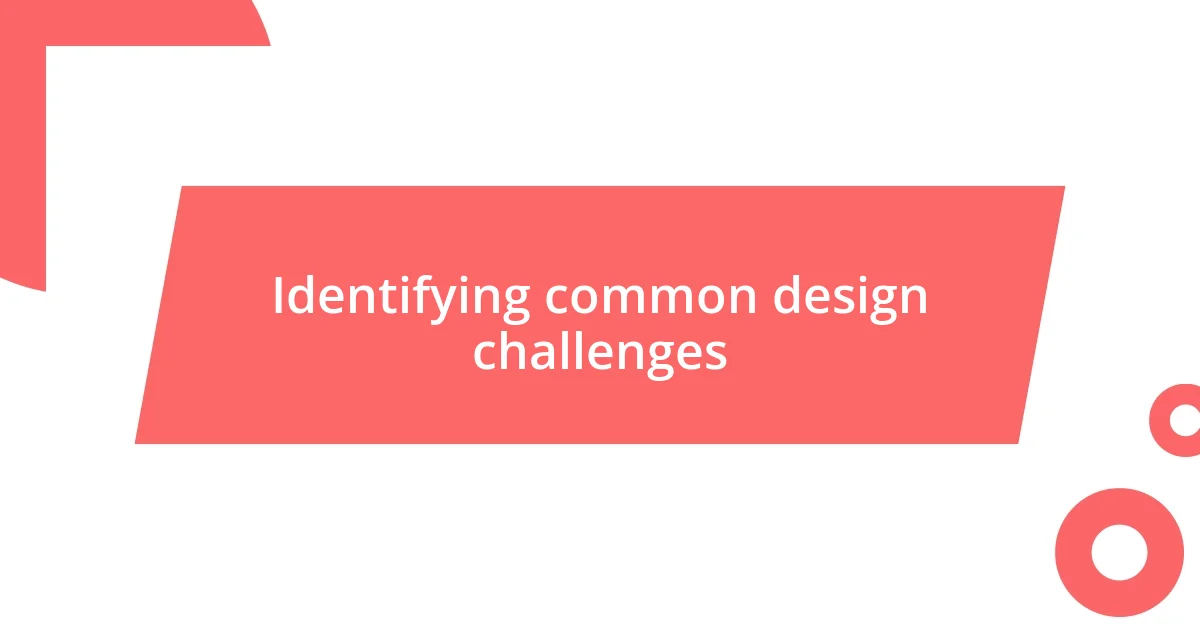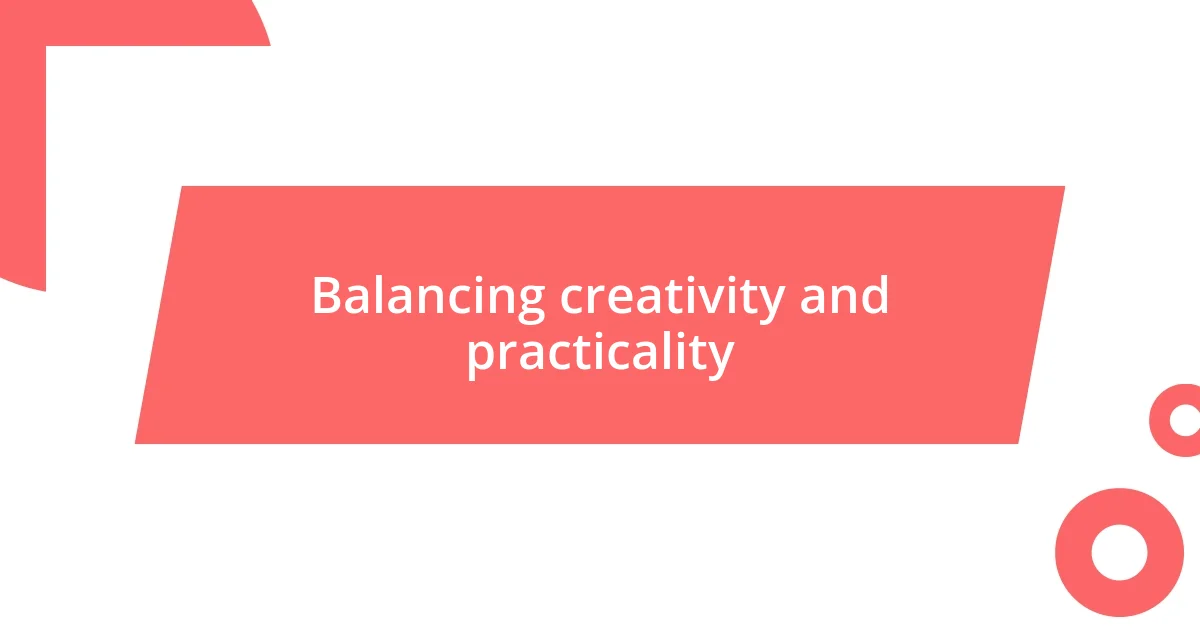Key takeaways:
- Stage design combines storytelling, visual elements, and accessibility, influencing audience perception and emotional engagement.
- Collaboration and open communication among stakeholders are essential for harmonizing differing visions and creating an effective design.
- Utilizing technology, such as 3D modeling and augmented reality, enhances design processes, encourages creativity, and facilitates seamless collaboration.

Understanding stage design fundamentals
Stage design is more than just aesthetics; it’s about storytelling and setting the right mood. I remember working on a play where the set needed to transform from a cozy living room to a stark, eerie landscape within moments. What struck me was how these two seemingly opposing environments could be bridged through thoughtful design choices—like lighting and color palettes—which guided the audience’s emotions.
Understanding the fundamentals of stage design requires a grasp of space, texture, and light. For instance, when I first experimented with different materials, I was surprised by how wood and fabric could lend warmth and intimacy to a scene. Isn’t it fascinating how a single element can shift the entire atmosphere? This interplay between elements not only enhances the visual impact but also influences how performances are perceived, creating a richer experience for the audience.
Furthermore, accessibility in design is an often overlooked aspect. One of my earlier productions included a scene meant to underline a character’s isolation, yet I realized the audience in the back couldn’t see the actor’s subtle expressions. This experience taught me that stage design must consider all perspectives, prompting me to prioritize visibility and connectivity between performers and viewers. How well does your design communicate the story?

Identifying common design challenges
Identifying common design challenges often begins with recognizing the spatial limitations of a stage. In my early work, I faced the daunting task of trying to fit a bustling street scene onto a relatively small platform. Initially, it felt impossible to create depth without making the scene feel overcrowded. However, by simplifying the design and strategically placing elements, I managed to give the illusion of a larger space. This experience taught me the value of less is more; sometimes, a sparse design can convey complexity.
Another frequent challenge revolves around the integration of technology with traditional stagecraft. I recall an ambitious project where we attempted to use projections alongside physical sets. The challenge lay in ensuring that both elements harmonized rather than clashed. After several trials, I discovered that aligning the color schemes between projections and set pieces not only enhanced the overall aesthetic but also maintained the audience’s focus. Have you considered how technology complements your vision?
Lastly, timing in design execution can significantly impact the overall production. There was a moment in a rehearsal when lighting adjustments were made only an hour before the performance, leaving the actors unprepared. This slip created a chaotic atmosphere backstage. It reminded me of the crucial importance of planning and rehearsal timelines. Protecting the creative flow is imperative. So, how can you anticipate and navigate these timing hurdles?
| Design Challenge | Description |
|---|---|
| Spatial Limitations | Creating depth and understanding the constraints of the stage size. |
| Technology Integration | Balancing traditional elements with modern technology in a cohesive manner. |
| Timing Execution | Ensuring all design elements are correctly set up before performances to avoid chaos. |

Techniques for effective brainstorming
Brainstorming techniques can truly make or break a stage design project. I’ve found that creating a relaxed atmosphere fosters creativity. During one particularly intense meeting, we turned off the lights and lit candles to simulate a more intimate setting. This simple change opened up discussions and enabled everyone to contribute their wildest ideas without the pressure of judgment.
To guide your brainstorming effectively, consider these techniques:
- Mind Mapping: Sketch out ideas visually to see how they connect and evolve.
- Role-Playing: Take on different character perspectives to understand their needs and how they interact with the space.
- Silent Brainstorming: Allow everyone to jot down ideas independently before sharing; this often leads to thought-provoking insights.
- Word Association: Use a single word related to your theme and build associations to spark unexpected ideas.
- Time Constraints: Set a timer for intense bursts of idea generation, which can bring out creative solutions under pressure.
One of my most rewarding experiences happened when we engaged in a rapid-fire brainstorming session on a whim. With just 15 minutes on the clock, the team produced dozens of concepts for our next show, some of which led to unexpected yet brilliant ideas. It was exhilarating, proving that embracing spontaneity can yield remarkable outcomes.

Collaborating with project stakeholders
Collaborating with project stakeholders is where the essence of stage design truly comes alive. I remember a project where our team had to work closely with directors, producers, and even the marketing department. Each had their own vision, and negotiating these perspectives sometimes felt like herding cats. But through open communication, we transformed our brainstorming sessions into a melting pot of ideas. Suddenly, what seemed like conflicting visions began to harmonize, creating a design that everyone felt invested in. Have you found that collaboration invigorates your workflow?
As we navigated this project, I quickly realized that listening was just as crucial as sharing my own ideas. In one memorable meeting, a producer mentioned a specific audience demographic we hadn’t considered. This insight shifted our entire approach—from the colors we chose to the layout of the stage. It’s fascinating how one piece of feedback can lead to a ripple of positive changes. How often do you take a moment to truly listen to the stakeholders around you?
I’ve also learned the value of setting clear expectations and timelines with stakeholders from the very start. There was a time when we experienced last-minute changes dictated by upper management, which sent our design timeline into a tailspin. I felt the weight of that chaos, and it taught me to establish firm deadlines and check-in points. This way, everyone remains on the same page, and it fosters a collaborative spirit where creativity can thrive without the looming stress of uncertainty. What strategies do you use to keep everyone aligned during a project?

Utilizing technology in design
Utilizing technology has been a game changer in my stage design projects. I remember the thrill of using 3D modeling software for the first time. The ability to visualize my concepts in a virtual environment helped me communicate my ideas more effectively to the team. It’s like having a digital canvas; you can manipulate and experiment with different configurations instantly. Have you ever experienced that “aha!” moment when technology brings your vision to life?
Another invaluable tool has been augmented reality (AR). During a recent project, we implemented AR to allow stakeholders to walk through the stage design before it was built. It was a revelation to see their faces light up as they experienced the space in a new way. This level of immersion not only generated excitement but also led to immediate feedback that fine-tuned our design. Have you considered how AR could enhance your projects?
Technology also enables seamless collaboration, especially when working with teams spread across different locations. Utilizing platforms for real-time updates and digital collaboration allows us to tackle any roadblocks quickly. There was a time when a last-minute design tweak led to panic—communication faltered, and details slipped through the cracks. But now, with digital tools in hand, I feel empowered to adapt on the fly and keep everyone informed. How do you leverage technology to stay connected and agile in your design process?

Balancing creativity and practicality
Balancing creativity with practicality often feels like a tightrope walk, doesn’t it? I vividly recall a project where my vision involved intricate, elaborate designs that excited me. However, as the budget discussions unfolded, reality hit. I had to strip back some of my ambitious ideas to meet financial constraints, which was a tough pill to swallow. Yet, in that process, I discovered beauty in simplicity. Have you ever had to rein in your creativity to make it fit a realistic mold?
There’s a certain adrenaline rush when I brainstorm wild ideas, but I’ve learned that practical constraints often spark even greater creativity. For instance, during a recent show, we had to work with a restricted backstage area. Initially, I felt suffocated by the limitations, but it forced me to innovate. I created multi-functional design elements that not only utilized the space effectively but also added layers of visual interest. How have constraints pushed you to think creatively?
Ultimately, I’ve found that hybridizing innovative designs with practical schedules or budgets isn’t just about compromise—it’s an opportunity. One of my proudest moments came from reimagining a stage for a multigenre festival. We needed to cater to various performances without sacrificing aesthetic appeal or functionality. The result was a fluid design that adapted seamlessly across different acts. Have you ever created something that thrived within limits?














